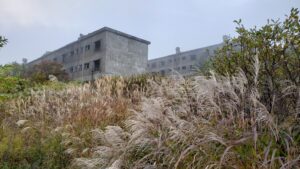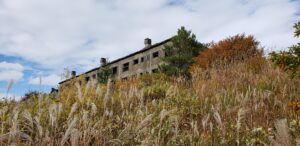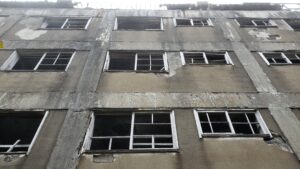The Present-Day Legacy of Matsuo Mine
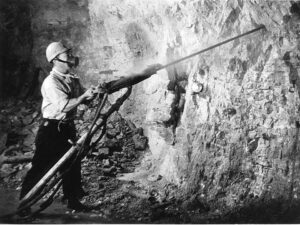
Over its five and a half decades of operation Matsuo Mine extracted some 29 million tons of sulfur and iron sulfide ore from the mountain, producing 10 million tons of sulfuric acid and 2.1 million tons of refined sulfur. And while on the one hand the legacy of those 55 years is a tale of visionary corporate management that invested generously in the day-to-day welfare of its workers, on the other lies a far more bleak reality: severe river and forest pollution left largely unattended until the mine’s demise.
Rainfall on the mine’s exposed slopes and groundwater from its galleries mix with the copious amounts of iron sulfide ore in the mountain to create a highly acidic, arsenic-laden discharge known as acid mine drainage, or AMD. Typical of mines developed in the late 1800s and early 1900s before more stringent environmental standards were in place, Matsuo used gravity drainage to divert this water from its network of underground galleries. The forest and water pollution caused by this lethal runoff into the soil and surrounding waterways is a crisis requiring non-stop management to this day. By the 1970s, pollution of the Kitakami River, the longest waterway in the Tohoku region, was so severe the river had been declared “dead,” its degradation stretching all the way to Morioka.
Water Neutralization Plant - The Recovery Process
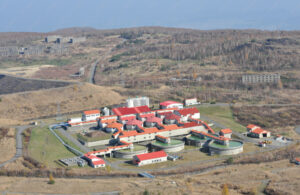
Construction of a water neutralization plant and a sludge storage dam at the abandoned mine site began in 1976 and was completed in 1981. While the river pollution has since been reversed through ongoing measures involving bacterial oxidation and calcium carbonate treatment, in 2012 authorities stated that if neutralization operations were suspended the ensuing economic damage to the Kitakami River basin, on which people depend for agricultural, industrial, and household water, would amount to nearly 50 billion yen per year. AMD remains a round-the-clock concern in Hachimantai, 365 days a year.
The plant today neutralizes 18 cubic meters of acidic wastewater per minute at an annual cost of 500 million yen, a sobering fiscal reality that far exceeds whatever profit was made over the lifetime of the mine. Prefectural authorities do not sugarcoat the situation, maintaining that the lessons of Matsuo carry import for present-day dialogue on resource extraction and economic policy. Tours of the treatment facility for groups of 10 to 30 people aged nine years and older can be booked on weekdays up to a week in advance.
Since 2005, a growing number of citizens have joined the effort to restore plant life on the slopes. Their work has succeeded in establishing grasslands on acreage that had been stripped bare by open-cut mining, or was used for slag-heap deposits. Forest regeneration and related environmental studies continue apace. From 2004 to 2017, a total of 66,680 tree seedlings have been planted, including oak, cherry, chestnut, and larch.
